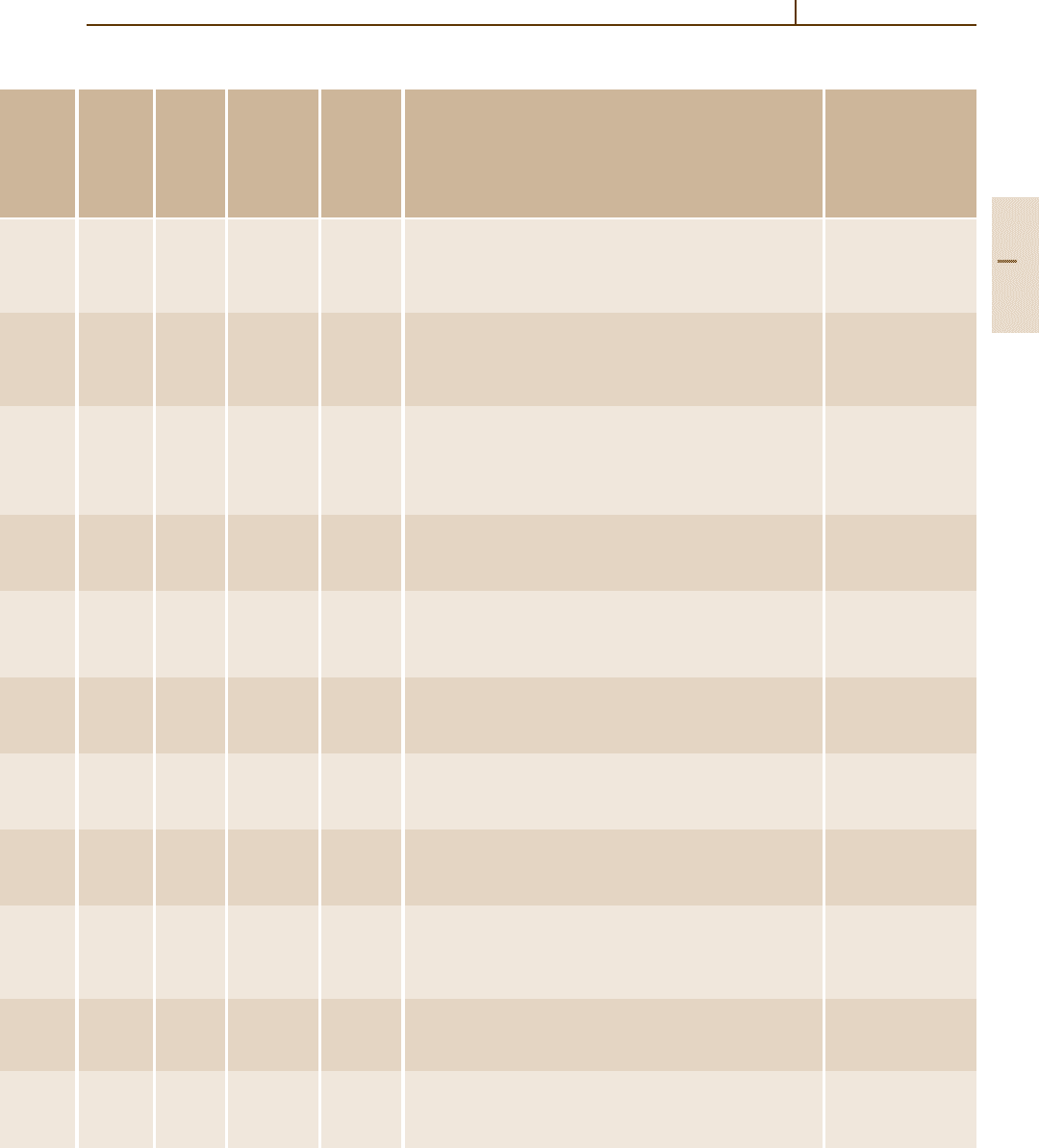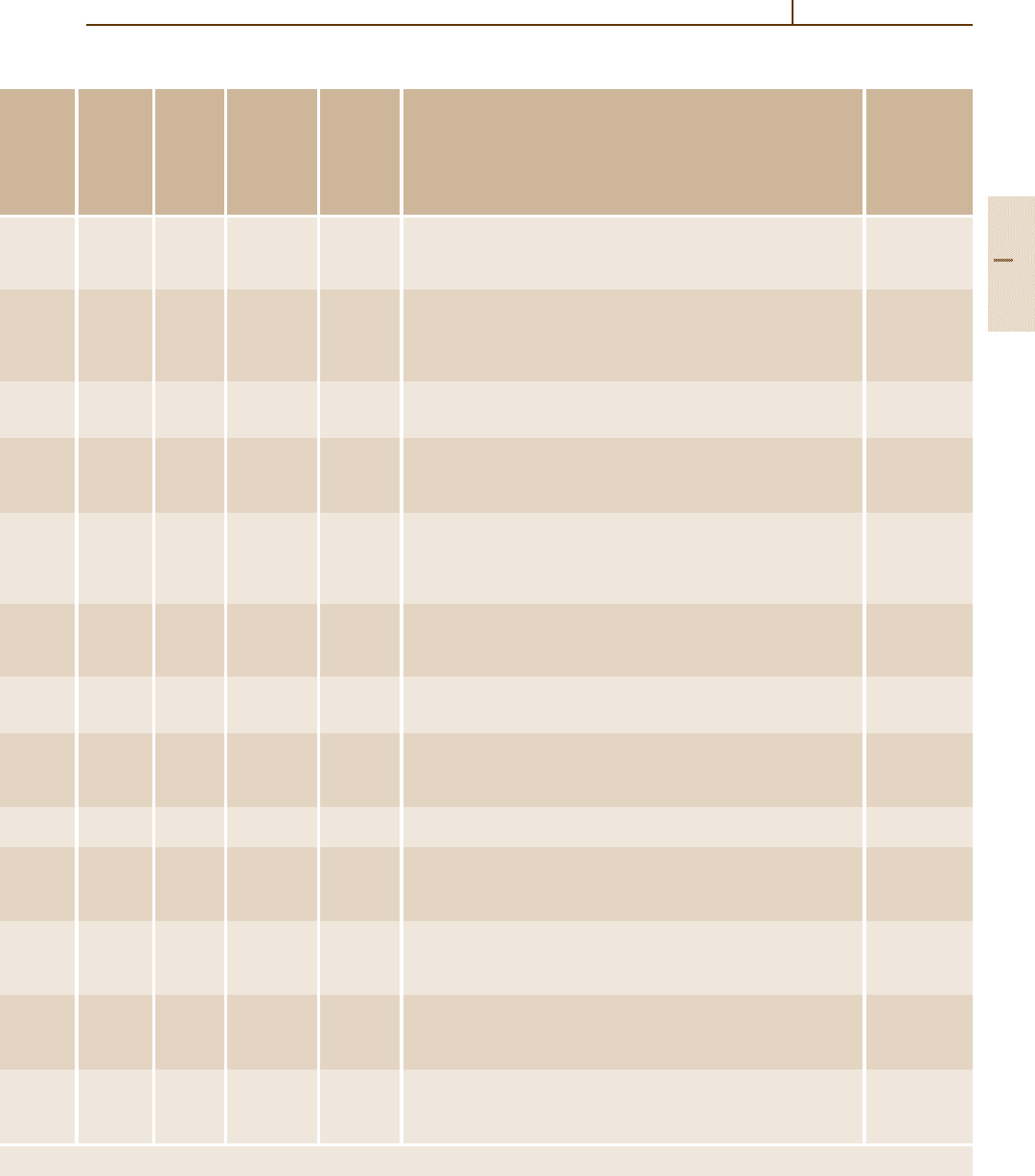Martienssen W., Warlimont H. (Eds.). Handbook of Condensed Matter and Materials Data
Подождите немного. Документ загружается.


462 Part 3 Classes of Materials
Table 3.2-20 Physical properties of carbides and carbide-based high-temperature refractories [2.4], cont.
IUPAC name
(synonyms,
and common
trade names)
Theoretical
chemical
formula,
[CASRN],
relative
molecular mass
(
12
C =12.000)
Crystal system,
lattice parameters,
Strukturbericht
symbol,
Pearson symbol,
space group,
structure type (Z)
Density
(,kg m
−3
)
Electrical
resistivity
(ρ,µ cm)
Melting
point (
◦
C)
Thermal
conductivity
(κ, Wm
−1
K
−1
)
Specific heat
capacity
(c
p
,Jkg
−1
K
−1
)
Coefficient
of linear
thermal
expansion
(α,10
−6
K
−1
)
Silicon
monocarbide
(moissanite,
Carbolon
r
,
Crystolon
r
,
Carborundum
r
)
α-SiC
[409-21-2]
40.097
Hexagonal
a =308.10 pm
c =503.94 pm
B4, hP4, P6
3
/mmc,
wurtzite type
(Z = 2)
3160 4.1×10
5
2093
transform-
ation
temperature
42.5 690 4.3–4.6
Silicon
monocarbide
(Carbolon
r
,
Crystolon
r
,
Carborundum
r
)
β-SiC
[409-21-2]
40.097
Cubic
a =435.90 pm
B3, cF8, F43m,
ZnS type (Z = 4)
3160 107 – 200 ∼ 2700,
subl.
135 1205 4.5
Tantalum
hemicarbide
Ta
2
C
[12070-07-4]
373.907
Hexagonal
a =310.60 pm
c =493.00 pm
L
3, hP3, P6
3
/mmc,
Fe
2
N type (Z = 2)
15 100 80.0 3327 – – –
Tantalum
monocarbide
TaC
[12070-06-3]
194.955
Cubic
a =445.55 pm
B1, cF8, Fm3m,
rock salt type
(Z = 4)
14 800 30 – 42.1 3880 22.2 190 6.64 – 8.4
Thorium
dicarbide
α-ThC
2
[12071-31-7]
256.060
Tetragonal
a =585 pm
c =528 pm
C11a, tI6, I4mmm,
CaC
2
type (Z = 2)
8960 – 9600 30.0 2655 23.9 – 8.46
Thorium
monocarbide
ThC
[12012-16-7]
244.089
Cubic
a=534.60 pm
B1, cF8, Fm3m,
rock salt type (Z=4)
10 670 25.0 2621 28.9 – 6.48
Titanium
monocarbide
TiC
[12070-08-5]
59.878
Cubic
a =432.8pm
B1, cF8, Fm3m,
rock salt type
(Z = 4)
4938 52.5 3140 ±90 17–21 – 7.5–7.7
Tungsten
hemicarbide
W
2
C
[12070-13-2]
379.691
Hexagonal
a =299.82 pm
c =472.20 pm
L
3, hP3, P6
3
/mmc,
Fe
2
N type (Z = 1)
17 340 81.0 2730 – – 3.84
Tungsten
monocarbide
(Widia
r
)
WC
[12070-12-1]
195.851
Hexagonal
a =290.63 pm
c =283.86 pm
L
3, hP3, P6
3
/mmc,
Fe
2
N type (Z = 1)
15 630 19.2 2870 121 – 6.9
Part 3 2.5

Ceramics 2.5 Non-Oxide Ceramics 463
Table 3.2-20 Physical properties of carbides and carbide-based high-temperature refractories [2.4], cont.
Young’s
modulus
(E,GPa)
Flexural
strength
(τ,MPa)
Compressive
strength
(α,MPa)
Vickers
hardness
HV
(Mohs
hardness
HM)
Other physicochemical properties, corrosion resistance,
a
and uses
IUPAC name
(synonyms
and common
trade names)
386 – 414 – 500 2400 – 2500
(HM 9.2)
Semiconductor (E
g
=3.03 eV). Soluble in fused alkalimetal hydrox-
ides.
Silicon
monocarbide
(moissanite,
Carbolon
r
,
Crystolon
r
,
Carborundum
r
)
262 – 468 – 1000 2700 – 3350
(HM 9.5)
Green to bluish-black, iridescent crystals. Soluble in fused
alkalimetal hydroxides. Abrasives made from this material are best
suited to the grinding of low-tensile-strength materials such as cast
iron, brass, bronze, marble, concrete, stone, glass, optical,
structural, and wear-resistant components. Corroded by molten
metals such as Na, Mg, Al, Zn, Fe, Sn, Rb, and Bi. Resistant to
oxidation in air up to 1650
◦
C. Maximum operating temperature of
2000
◦
C in reducing or inert atmosphere.
Silicon
monocarbide
(Carbolon
r
,
Crystolon
r
,
Carborundum
r
)
– – – 1714 – 2000 Tantalum
hemicarbide
364 – – 1599 – 1800
(HM 9 – 10)
Golden-brown crystals, soluble in HF-HNO
3
mixture. Used in
crucibles for melting ZrO
2
and similar oxides with high melting
points. Corrosion-resistant to molten metals such as Ta, and Re.
Readily corroded by liquid metals such as Nb, Mo, and Sn. Burning
occurs in pure oxygen above 800
◦
C. Severe oxidation in air above
1100–1400
◦
C. Maximum operating temperature of 3760
◦
C under
helium.
Tantalum
monocarbide
– – – 600 α – β transition at 1427
◦
C and β – γ transition at 1497
◦
C.
Decomposed by H
2
O with evolution of C
2
H
6
.
Thorium
dicarbide
– – – 1000 Readily hydrolyzed in water, evolving C
2
H
6
. Thorium
monocarbide
310 – 462 – 1310 2620 – 3200
(HM 9 – 10)
Gray crystals. Superconducting at 1.1 K. Soluble in HNO
3
and
aqua regia. Resistant to oxidation in air up to 450
◦
C. Maximum
operating temperature 3000
◦
C under helium. Used in crucibles for
handling molten metals such as Na, Bi, Zn, Pb, Sn, Rb, and Cd.
Corroded by the following liquid metals: Mg, Al, Si, Ti, Zr, V, Nb,
Ta, Cr, Mo, Mn, Fe, Co, and Ni. Attacked by molten NaOH.
Titanium
monocarbide
421 – – 3000 Black. Resistant to oxidation in air up to 700
◦
C.
Corrosion-resistant to Mo.
Tungsten
hemicarbide
710 – 530 2700
(HM>9)
Gray powder, dissolved by HF-HNO
3
mixture. Cutting tools,
wear-resistant semiconductor films. Corroded by the following
molten metals: Mg, Al, V, Cr, Mn, Ni, Cu, Zn, Nb, and Mo.
Corrosion-resistant to molten Sn.
Tungsten
monocarbide
(Widia
r
)
Part 3 2.5

464 Part 3 Classes of Materials
Table 3.2-20 Physical properties of carbides and carbide-based high-temperature refractories [2.4], cont.
IUPAC name
(synonyms,
and common
trade names)
Theoretical
chemical
formula,
[CASRN],
relative
molecular mass
(
12
C =12.000)
Crystal system,
lattice parameters,
Strukturbericht
symbol,
Pearson symbol,
space group,
structure type (Z)
Density
(,kg m
−3
)
Electrical
resistivity
(ρ,µ cm)
Melting
point (
◦
C)
Thermal
conductivity
(κ, Wm
−1
K
−1
)
Specific heat
capacity
(c
p
,Jkg
−1
K
−1
)
Coefficient
of linear
thermal
expansion
(α,10
−6
K
−1
)
Uranium
carbide
U
2
C
3
[12076-62-9]
512.091
Cubic
a =808.89 pm
D5c, cI40, I
¯
43d,
Pu
2
C
3
type (Z = 8)
12 880 – 1777 – – 11.4
Uranium
dicarbide
UC
2
[12071-33-9]
262.051
Tetragonal
a =352.24 pm
c =599.62 pm
C11a, ti6, I 4/mmm,
CaC
2
type (Z = 2)
11 280 – 2350 – 2398 32.7 147 14.6
Uranium
monocarbide
UC
[12070-09-6]
250.040
Cubic
a =496.05 pm
B1, cF8, Fm3m,
rock salt type (Z = 4)
13 630 50.0 2370 – 2790 23.0 – 11.4
Vanadium
hemicarbide
V
2
C
[2012-17-8]
113.89
Hexagonal
a =286 pm
c =454 pm
L
3, hP3, P6
3
mmc,
Fe
2
N type (Z = 2)
5750 – 2166 – – –
Vanadium
monocarbide
VC
[12070-10-9]
62.953
Cubic
a =413.55 pm
B1, cF8, Fm3m,
rock salt type (Z = 4)
5770 65.0 – 98.0 2810 24.8 – 4.9
Zirconium
monocarbide
ZrC
[12020-14-3]
103.235
Cubic
a =469.83 pm
B1, cF8, Fm3m,
rock salt type
(Z = 4)
6730 68.0 3540 – 3560 20.61 205 6.82
a
Corrosion data in molten salts from [2.9].
Part 3 2.5

Ceramics 2.5 Non-Oxide Ceramics 465
Table 3.2-20 Physical properties of carbides and carbide-based high-temperature refractories [2.4], cont.
Young’s
modulus
(E,GPa)
Flexural
strength
(τ,MPa)
Compressive
strength
(α,MPa)
Vickers
hardness
HV
(Mohs
hardness
HM)
Other physicochemical properties, corrosion resistance,
a
and uses
IUPAC name
(synonyms
and common
trade names)
179 – 221 – 434 – Uranium
carbide
– – – 600 Transition from tetragonal to cubic at 1765
◦
C. Decomposed in
H
2
O, slightly soluble in alcohol. Used in microsphere pellets to
fuel nuclear reactors.
Uranium
dicarbide
172.4 – 351.6 750 – 935
(HM>7)
Gray crystals with metallic appearance, reacts with oxygen.
Corroded by the following molten metals: Be, Si, Ni, and Zr.
Uranium
monocarbide
– – – 3000 Corroded by molten Nb, Mo, and Ta. Vanadium
hemicarbide
614 – 613 2090 Black crystals, soluble in HNO
3
with decomposition. Used in
wear-resistant films and cutting tools. Resistant to oxidation in air
up to 300
◦
C.
Vanadium
monocarbide
345 – 1641 1830 – 2930
(HM>8)
Dark gray, brittle solid, soluble in HF solutions containing nitrates
or peroxide ions. Used in nuclear power reactors and in crucibles
for handling molten metals such as Bi, Cd, Pb, Sn, and Rb, and
molten zirconia (ZrO
2
). Corroded by the following liquid metals:
Mg, Al, Si, V, Nb, Ta, Cr, Mo, Mn, Fe, Co, Ni, and Zn. In air,
oxidized rapidly above 500
◦
C. Maximum operating temperature of
2350
◦
C under helium.
Zirconium
monocarbide
Part 3 2.5

466 Part 3 Classes of Materials
Table 3.2-21 Properties of carbides according to DIN EN 60672 [2.6]
Designation
SSIC SISIC RSIC NSIC BC
Silicon carbide, Silicon carbide, Silicon carbide, Silicon carbide, Boron carbide
Mechanical
sintered silicon- recrystallized nitride-bonded
properties Symbol Units infiltrated
Open porosity vol. % 0 0 0–15 − 0
Density, minimum Mg/m
3
3.08 – 3.15 3.08 – 3.12 2.6 – 2.8 2.82 2.50
Bending σ
B
MPa 300– 600 180 – 450 80 – 120 200 400
strength
Young’s E GPa 370 – 450 270 – 350 230 – 280 150 – 240 390 – 440
modulus
Hardness HV 100 25–26 14–25 25 − 30–40
Fracture K
IC
MPa
√
m
3.0 – 4.8 3.0–5.0 3.0 − 3.2–3.6
toughness
Electrical
properties
Resistivity ρ
20
Ω m 10
3
–10
4
2×10
1
–10
3
− − −
at 20
◦
C
Resistivity ρ
600
Ω m 10 5 − − −
at 600
◦
C
Thermal
properties
Average coefficient α
30−1000
10
−6
K
−1
4–4.8 4.3–4.8 4.8 4.5 6
of thermal expansion
at 30–600
◦
C
Specific heat capacity c
p,30−1000
Jkg
−1
K
−1
600 – 1000 650 – 1000 600 – 900 800 – 900 −
at 30–100
◦
C
Thermal λ
30−100
Wm
−1
K
−1
40 – 120 110 – 160 20 14–15 28
conductivity
Thermal fatigue (Rated) Very good Very good Very good Very good −
resistance
Typical maximum T
◦
C 1400 – 1750 1380 1600 1450 700 – 1000
application
temperature
Part 3 2.5

Ceramics 2.5 Non-Oxide Ceramics 467
3.2.5.4 Nitrides
Nitrides are treated extensively in [2.1–3]. Some prop-
erties are listed in Tables 3.2-22 and 3.2-23.
Silicon Nitride
Si
3
N
4
is the dominant nitride ceramic material because
of its favorable combination of properties. The prepara-
tion of powders for the formation of dense silicon nitride
Table 3.2-22 Properties of nitrides according to DIN EN 60672 [2.6]
Designation
SSN RBSN HPSN SRBSN AlN
Silicon Silicon Silicon Silicon Aluminium
nitride, nitride, nitride, nitride, nitride
Mechanical sintered reaction- hot-pressed reaction-
properties Symbol Units bonded bonded
Open porosity vol. % − − 0 − 0
Density, minimum Mg/m
3
3–3.3 1.9–2.5 3.2–3.4 3.1 – 3.3 3.0
Bending strength σ
B
MPa 700 – 1000 200– 330 600 – 800 700 – 1200 200
Young’s modulus E GPa 250 – 330 80 – 180 600– 800 150 – 240 320
Hardness HV 100 4–18 8–10 15–16 − 11
Fracture toughness K
IC
MPa
√
m
5–8.5 1.8–4.0 6.0–8.5 3.0 – 6? 3.0
Electrical
properties
Resistivity ρ
20
Ω m 10
11
10
13
10
13
− 10
13
at 20
◦
C
Resistivity ρ
600
Ω m 10
2
10
10
10
9
− 10
12
at 600
◦
C
Thermal
properties
Average coefficient α
30−1000
10
−6
K
−1
2.5–3.5 2.1–3 3.1–3.3 3.0 – 3.4 4.5 – 5
of thermal expansion
at 30–600
◦
C
Specific heat capacity c
p,30−1000
Jkg
−1
K
−1
700 – 850 700 – 850 700 – 850 700 – 850 −
at 30–100
◦
C
Thermal λ
30−100
Wm
−1
K
−1
15–45 4–15 15–40 14–15 > 100
conductivity
Thermal fatigue (Rated) Very good Very good Very good Very good Very good
resistance
Typical maximum T
◦
C 1250 1100 1400 1250 −
application
temperature
materials requires the use of precursors. Four routes
for the production of Si
3
N
4
powders are used in prac-
tice: nitridation of silicon, chemical vapor deposition
from SiCl
4
+NH
3
, carbothermal reaction of SiO
2
, and
precipitation of silicon diimide Si(NH)
2
followed by
decomposition. Table 3.2-24 gives examples of the prop-
erties of the resulting powders.
Part 3 2.5

468 Part 3 Classes of Materials
Table 3.2-23 Physical properties of nitrides and nitride-based high-temperature refractories [2.4]
IUPAC name
(synonyms
and common
trade names)
Theoretical
chemical
formula,
[CASRN],
relative
molecular mass
(
12
C =12.000)
Crystal system,
lattice parameters,
Strukturbericht
symbol,
Pearson symbol,
space group,
structure type, Z
Density
(,kg m
−3
)
Electrical
resistivity
(ρ,µ cm)
Melting
point (
◦
C)
Thermal
conductivity
(κ, Wm
−1
K
−1
)
Specific heat
capacity
(c
p
,Jkg
−1
K
−1
)
Coefficient
of linear
thermal
expansion
(α,10
−6
K
−1
)
Aluminium
mononitride
AIN
[24304-00-5]
40.989
Hexagonal
a =311.0pm
c =497.5pm
B4, hP4, P6
3
mc,
wurtzite type (Z = 2)
3050 10
17
2230 29.96 820 5.3
Beryllium
nitride
α-Be
3
N
2
[1304-54-7]
55.050
Cubic
a =814 pm
D5
3
, cI80, Ia3,
Mn
2
O
3
type
(Z = 16)
2710 – 2200 – 1221 –
Boron
mononitride
BN
[10043-11-5]
24.818
Hexagonal
a =250.4pm
c =666.1pm
B
k
, hP8, P6
3
/mmc,
BN type (Z = 4)
2250 10
19
2730 (dec.) 15.41 711 7.54
Boron
mononitride
(Borazon
r
,
CBN)
BN
24.818
Cubic
a =361.5pm
3430 1900
(200
◦
C)
1540 – – –
Chromium
heminitride
Cr
2
N
[12053-27-9]
117.999
Hexagonal
a =274 pm
c =445 pm
L
3, hP3, P6
3
/mmc,
Fe
2
N type (Z = 1)
6800 76 1661 22.5 630 9.36
Chromium
mononitride
CrN
[24094-93-7]
66.003
Cubic
a =415.0pm
B1, cF8, Fm3m, rock
salt type (Z = 4)
6140 640 1499 (dec.) 12.1 795 2.34
Hafnium
mononitride
HfN
[25817-87-2]
192.497
Cubic
a =451.8pm
B1, cF8, Fm3m, rock
salt type (Z = 4)
13 840 33 3310 21.6 210 6.5
Molybdenum
heminitride
Mo
2
N
[12033-31-7]
205.887
Cubic
a =416 pm
L
1, cP5, Pm3m,
Fe
4
N type (Z = 2)
9460 19.8 760 – 899 17.9 293 6.12
Molybdenum
mononitride
MoN
[12033-19-1]
109.947
Hexagonal
a =572.5pm
c =560.8pm
B
h
, hP2, P6/mmm,
WC type (Z = 1)
9180 – 1749 – – –
Niobium
mononitride
NbN
[24621-21-4]
106.913
Cubic
a =438.8pm
B1, cF8, Fm3m, rock
salt type (Z = 4)
8470 78 2575 3.63 – 10.1
Silicon
nitride
β-Si
3
N
4
[12033-89-5]
140.284
Hexagonal
a =760.8pm
c =291.1pm
P6/3m
3170 10
6
1850 28 713 2.25
Part 3 2.5

Ceramics 2.5 Non-Oxide Ceramics 469
Table 3.2-23 Physical properties of nitrides and nitride-based high-temperature refractories [2.4], cont.
Young’s
modulus
(E,GPa)
Flexural
strength
(τ,MPa)
Compressive
strength
(α,MPa)
Vickers
hardness
HV
(Mohs
hardness
HM)
Other physicochemical properties, corrosion resistance,
a
and uses
IUPAC name
(synonyms
and common
trade names)
346 – 2068 1200
(HM 9 – 10)
Insulator (E
g
= 4.26 eV). Decomposed by water, acids, and alkalis
to Al(OH)
3
and NH
3
. Used in crucibles for GaAs crystal growth.
Aluminium
mononitride
– – – – Hard white or grayish crystals. Oxidized in air above 600
◦
C.
Slowly decomposed in water, quickly in acids and alkalis, with
evolution of NH
3
.
Beryllium
nitride
85.5 – 310 230
(HM 2.0)
Insulator (E
g
= 7.5 eV). Used in crucibles for molten metals such
as Na, B, Fe, Ni, Al, Si, Cu, Mg, Zn, In, Bi, Rb, Cd, Ge, and Sn.
Corroded by these molten metals: U, Pt, V, Ce, Be, Mo, Mn, Cr, V,
and Al. Attacked by the following molten salts: PbO
2
,Sb
2
O
3
,
Bi
2
O
3
, KOH, and K
2
CO
3
. Used in furnace insulation, diffusion
masks, and passivation layers.
Boron
mononitride
– – 7000 4700 – 5000
(HM 10)
Tiny reddish to black grains. Used as an abrasive for grinding tool
and die steels and high-alloy steels when chemical reactivity of
diamond is a problem.
Boron
mononitride
(Borazon
r
,
CBN)
– – – 1200 – 1571 Chromium
heminitride
– – – 1090 Chromium
mononitride
– – – 1640
(HM> 8−9)
Most refractory of all nitrides. Hafnium
mononitride
– – – 1700 Phase transition at 5.0K. Molybdenum
heminitride
– – – 650 Molybdenum
mononitride
– – – 1400
(HM> 8)
Dark gray crystals. Transition temperature 15.2 K. Insoluble in
HCl, HNO
3
,andH
2
SO
4
, but attacked by hot caustic solutions,
lime, or strong alkalis, evolving NH
3
.
Niobium
mononitride
55 – – (HM>9) Silicon
nitride
Part 3 2.5

470 Part 3 Classes of Materials
Table 3.2-23 Physical properties of nitrides and nitride-based high-temperature refractories [2.4], cont.
IUPAC name
(synonyms
and common
trade names)
Theoretical
chemical
formula,
[CASRN],
relative
molecular mass
(
12
C =12.000)
Crystal system,
lattice parameters,
Strukturbericht
symbol,
Pearson symbol,
space group,
structure type, Z
Density
(,kg m
−3
)
Electrical
resistivity
(ρ,µ cm)
Melting
point (
◦
C)
Thermal
conductivity
(κ, Wm
−1
K
−1
)
Specific heat
capacity
(c
p
,Jkg
−1
K
−1
)
Coefficient
of linear
thermal
expansion
(α,10
−6
K
−1
)
Silicon nitride
(Nitrasil
r
)
α-Si
3
N
4
[12033-89-5]
140.284
Hexagonal
a =775.88 pm
c =561.30 pm
P31c
3184 10
19
1900 (sub.) 17 700 2.5 – 3.3
Tantalum
heminitride
Ta
2
N
375.901
Hexagonal
a =306 pm
c =496 pm
L
3, hP3, P6
3
/mmc,
Fe
2
N type (Z = 1)
15 600 263 2980 10.04 126 5.2
Tantalum
mononitride
()
TaN
[12033-62-4]
194.955
Hexagonal
a =519.1pm
c =290.6pm
13 800 128 – 135 3093 8.31 210 3.2
Thorium
mononitride
ThN
[12033-65-7]
246.045
Cubic
a =515.9
B1, cF8, Fm3m, rock
salt type (Z = 4)
11 560 20 2820 – – 7.38
Thorium
nitride
Th
2
N
3
[12033-90-8]
Hexagonal
a =388 pm
c =618 pm
D5
2
, hP5,
¯
3ml,
La
2
O
3
type (Z = 1)
10 400 – 1750 – – –
Titanium
mononitride
TiN
[25583-20-4]
61.874
Cubic
a =424.6pm
B1, cF8, Fm3m, rock
salt type (Z = 4)
5430 21.7 2930 (dec.) 29.1 586 9.35
Tungsten
dinitride
WN
2
[60922-26-1]
211.853
Hexagonal
a =289.3pm
c =282.6pm
7700 – 600 (dec.) – – –
Tungsten
heminitride
W
2
N
[12033-72-6]
381.687
Cubic
a =412 pm
L
1, cP5, Pm3m,
Fe
4
N type (Z = 2)
17 700 – 982 – – –
Tungsten
mononitride
WN
[12058-38-7]
Hexagonal 15 940 – 593 – – –
Uranium
nitride
U
2
N
3
[12033-83-9]
518.259
Cubic
a =1070 pm
D5
3
, c180, Ia3,
Mn
2
O
3
type (Z =16)
11 240 – – – – –
Uranium
mononitride
UN
[25658-43-9]
252.096
Cubic
a =489.0pm
B1, cF8, Fm3m, rock
salt type (Z = 4)
14 320 208 2900 12.5 188 9.72
Vanadium
mononitride
VN
[24646-85-3]
64.949
Cubic
a =414.0pm
B1, cF8, Fm3m, rock
salt type (Z = 4)
6102 86 2360 11.25 586 8.1
Zirconium
mononitride
ZrN
[25658-42-8]
105.231
Cubic
a =457.7pm
B1, cF8, Fm3m, rock
salt type (Z = 4)
7349 13.6 2980 20.90 377 7.24
Part 3 2.5

Ceramics 2.5 Non-Oxide Ceramics 471
Table 3.2-23 Physical properties of nitrides and nitride-based high-temperature refractories [2.4], cont.
Young’s
modulus
(E,GPa)
Flexural
strength
(τ,MPa)
Compressive
strength
(α,MPa)
Vickers
hardness
HV
(Mohs
hardness
HM)
Other physicochemical properties, corrosion resistance,
a
and uses IUAPC name
(synonyms
and common
trade names)
304 – – (HM>9) Gray amorphous powder or crystals. Corrosion-resistant to molten metals
such as Al, Pb, Zn, Cd, Bi, Rb, and Sn, and molten salts NaCl-KCl, NaF,
and silicate glasses. Corroded by molten Mg, Ti, V, Cr, Fe, Co, cryolite,
KOH, and Na
2
O.
Silicon nitride
(Nitrasil
r
)
– – – 3200 Decomposed by KOH with evolution of NH
3
. Tantalum
heminitride
– – – 1110
(HM>8)
Bronze-colored or black crystals. Transition temperature 1.8 K. Insoluble
in water, slowly attacked by aqua regia, HF, and HNO
3
.
Tantalum
mononitride
()
– – – 600 Gray solid. Slowly hydrolyzed by water. Thorium
mononitride
– – – – Thorium
nitride
248 – 972 1900
(HM8–9)
Bronze-colored powder. Transition temperature 4.2 K. Corrosion-resistant
to molten metals such as Al, Pb, Mg, Zn, Cd, and Bi. Corroded by molten
Na, Rb, Ti, V, Cr, Mn, Sn, Ni, Cu, Fe, and Co. Dissolved by boiling aqua
regia; decomposed by boiling alkalis, evolving NH
3
.
Titanium
mononitride
– – – – Brown crystals. Tungsten
dinitride
– – – – Gray crystals. Tungsten
heminitride
– – – – Gray solid. Slowly hydrolyzed by water. Tungsten
mononitride
– – – – Uranium
nitride
149 – – 455 Uranium
mononitride
– – – 1520
(HM 9 – 10)
Black powder. Transition temperature 7.5 K. Soluble in aqua regia. Vanadium
mononitride
– – 979 1480
(HM>8)
Yellow solid. Transition temperature 9 K. Corrosion-resistant to steel,
basic slag, and cryolite, and molten metals such as Al, Pb, Mg, Zn, Cd, and
Bi. Corroded by molten Be, Na, Rb, Ti, V, Cr, Mn, Sn, Ni, Cu, Fe, and Co.
Soluble in concentrated HF, slowly soluble in hot H
2
SO
4
.
Zirconium
mononitride
a
Corrosion data in molten salts from [2.9].
Part 3 2.5
